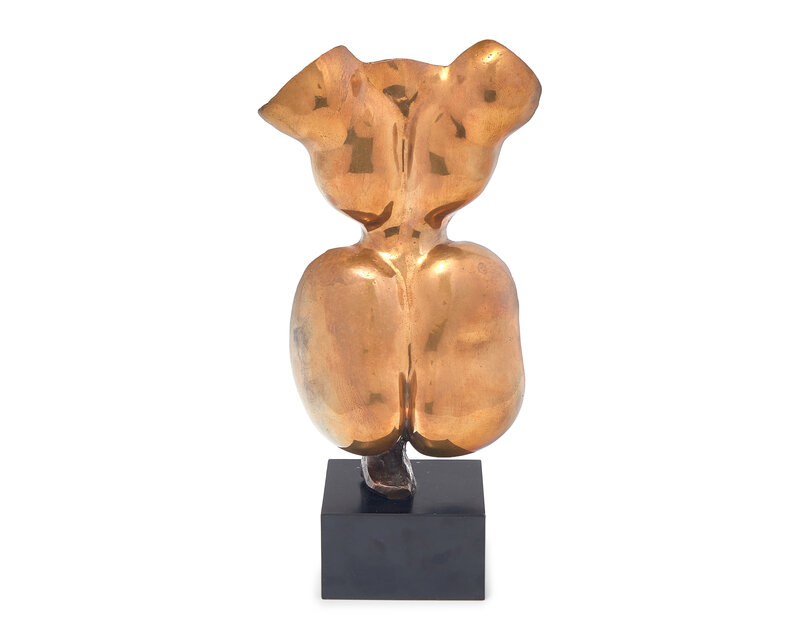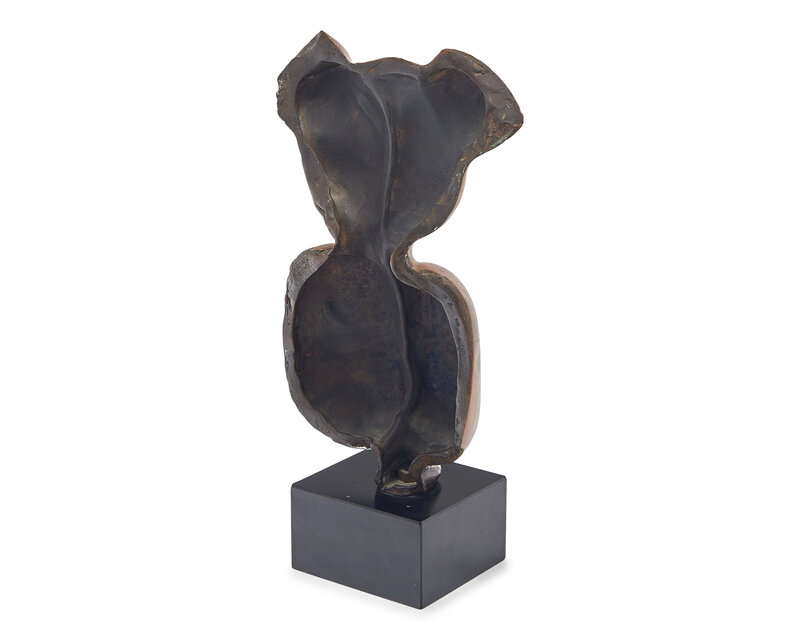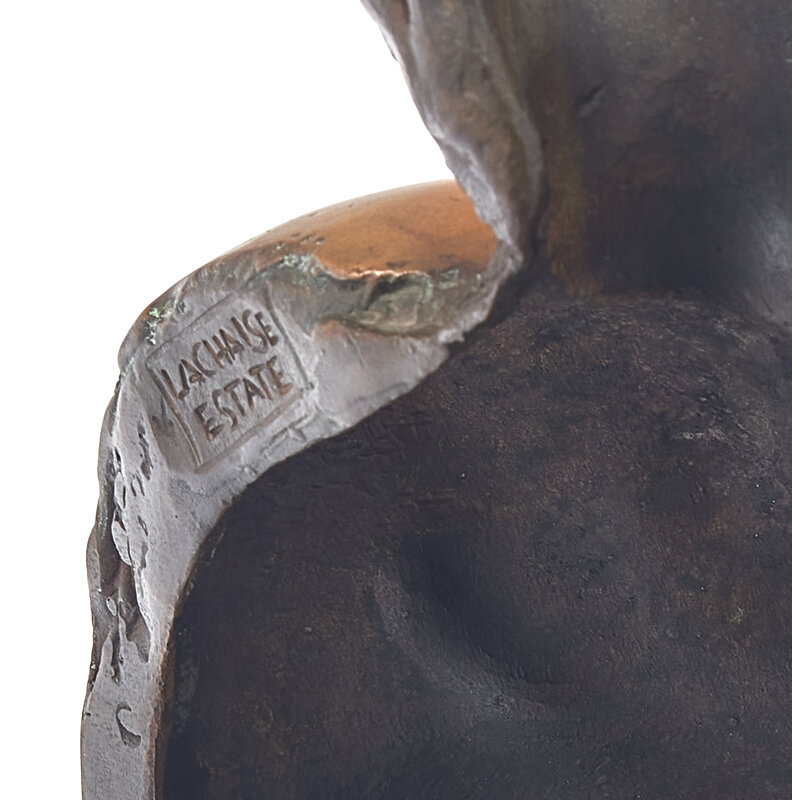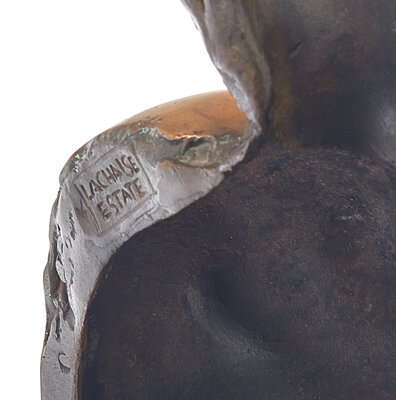Gaston Lachaise
(American/French, 1882–1935)
Torso (Second State) [LF 84]
Sale 2087 - Impressionist and Modern Art, Featuring the Collection of John and Rosetta Gernon
Oct 28, 2024
12:00PM ET
Live / Philadelphia
Own a similar item?
Estimate
$4,000 -
6,000
Price Realized
$3,810
Sold prices are inclusive of Buyer’s Premium
Lot Description
Gaston Lachaise
(American/French, 1882–1935)
Torso (Second State) [LF 84]
Bronze with golden patina on a black square lucite base
Stamped LACHAISE/ESTATE and numbered 1/10 (along the rim verso)
Model circa 1931; cast in 1964 (second state).
Model circa 1931; cast in 1964 (second state).
Height (not including base): 11 1/4 in. (28.6cm)
This lot is located in Philadelphia.
We wish to thank Virginia Budny, author of the forthcoming Catalogue Raisonné of Lachaise’s work (sponsored by the Lachaise Foundation), for her assistance in preparing the catalogue entry for the present work.
Provenance:
Lachaise Foundation, Boston, Massachusetts.
Robert Schoelkopf Gallery, New York, by September 1967.
Acquired directly from the above.
Private Collection.
Acquired directly from the above in July 1976.
Lachaise Foundation, Boston, Massachusetts.
Robert Schoelkopf Gallery, New York, by August 30, 1979.
Worthington Gallery, Chicago, Illinois, until March, 1985.
PS Galleries, Dallas, Texas.
Worthington Gallery, Chicago, Illinois.
Robert Schoelkopf Gallery, New York, New York.
Worthington Gallery, Chicago, Illinois.
Robert Schoelkopf Gallery, New York, New York.
Acquired directly from the above in 1988.
Private Collection, New York.
Thence by descent in the family to the present owner.
Literature:
Lincoln Kirstein, Gaston Lachaise, Retrospective Exhibition, an exhibition catalogue, Museum of Modern Art, New York, New York, 1935, p. 26, no. 43, plate 43 (another example illustrated).
Winslow Ames, “Gaston Lachaise, 1882-1935,” in Parnassus, Vol. 8, no. 3, March 1936, p. 7 (another example referenced).
Thomas H. Hess, “Gaston Lachaise Revived a Decade Later,” in Art News, vol. 45, no. 11, January 1947, p. 20 (another example illustrated).
Gaston Lachaise, 1882–1935, an exhibition catalogue, M. Knoedler & Co., New York, New York, 1947, 17, no. 29 (another example referenced).
Andrew Carnduff Ritchie, Sculpture of the Twentieth Century, Museum of Modern Art, New York, 1952, p. 119 (another example illustrated).
Arts of the United States, edited by William H. Pierson, Jr., and Martha Davidson, McGraw-Hill, New York, 1960, p. 389, no. 3769 (another example illustrated).
American Art of Our Century, Whitney Museum of American Art and Praeger, New York, 1961, pp. 61, 64 (another example illustrated).
Donald B. Goodall, Art in America, Vol. 51, no. 5, October 1963, p. 39 (another example illustrated).
Gaston Lachaise (1882-1935) Sculpture and Drawings, an exhibition catalogue, Los Angeles, Los Angeles County Museum of Art, 1963, no. 64 (another example illustrated).
Hilton Kramer, “Matisse as a Sculptor,” in Boston Museum Bulletin, Museum of Fine Art, Boston, Massachusetts, Vol. 64, no. 336, 1966, pp. 64, 65, fig. 14 (another example illustrated).
James R. Mellow, "Review of Robert Schoelkopf Gallery exhibition of Gaston Lachaise’s Sculpture and Drawings," in Art International, Vol. 10, no. 4, April 1966, p. 86 (one of the first two Estate casts illustrated).
Drawings & Sculpture by Gaston Lachaise, an exhibition catalogue, Robert Schoelkopf Gallery, New York, 1966, n.p., (one of the first two Estate casts illustrated).
Hilton Kramer, Hart Crane et al., The Sculpture of Gaston Lachaise, The Eakins Press, New York, 1967/1987, pp. 14-15, 53, no. 62 (one of the first two Estate casts illustrated).
Barbara Rose, Readings in American Art Since 1900: A Documentary Survey, New York: Frederick A. Praeger, 1968), n.p, fig. 66 (another example illustrated).
Donald Bannard Goodall, "Gaston Lachaise: Sculptor," PhD dissertation, Harvard University, 1969, Vol. 1, pp. 489, 552n.109, 580; Vol. 2, pp. 229-30, 446, plate CVIIII (the first state (bronze), the plaster model and another example (bronze) of the second state referenced without distinguishing the two states; the first state (bronze) illustrated).
Albert E. Elsen, The Partial Figure in Modern Sculpture: From Rodin to 1969, an exhibition catalogue, The Baltimore Museum of Art, Baltimore, 1970, pp. 50, no. 36 (another example illustrated).
Gaston Lachaise, 1882–1935, an exhibition catalogue, Cornell University Press, Ithaca, 1974, n.p. (another example referenced).
Gerald Nordland, Gaston Lachaise: The Man and His Work, New York, 1974, pp. 144-45, fig. 78 (another example illustrated).
John Wilmerding, American Art, Penguin Books, New York, 1976, p. 191, plate 204 (another example illustrated).
Rosalind E. Krauss, Passages in Modern Sculpture, Viking Press, New York, 1977, pp. 93-94, fig. 70 (another example illustrated).
Memorial Art Gallery of the University of Rochester, Gaston Lachaise: Sculpture and Drawings, an exhibition catalogue, University of Rochester, Rochester, 1979, pp. 8, 31, no. 34 (another example referenced).
Gaston Lachaise: Sculpture and Drawings, an exhibition catalogue, California State College, San Bernardino, 1980, pp. 38, 40, 50, no. 27, fig. 46 (another example illustrated).
Patterson Sims, Gaston Lachaise: A Concentration of Works from the Permanent Collection of the Whitney Museum of American Art, A 50th Anniversary Exhibition, an exhibition catalogue, The Whitney Museum of American Art, New York, 1980, pp. 24, [32] (another example illustrated).
The Figurative Tradition and the Whitney Museum of American Art: Paintings and Sculpture from the Permanent Collection,Whitney Museum of American Art, New York and University of Delaware Press, Newark, 1980, p. 98, fig. 80 (another example illustrated).
Herschel B. Chipp (essay by), Gaston Lachaise: 100th Anniversary Exhibition, Sculpture and Drawings, an exhibition catalogue, Palm Springs Desert Museum, Palm Springs, 1982, pp. 24, 34, no. 50 (possibly the present example illustrated).
Gaston Lachaise: Twenty Sculptures, an exhibition catalogue, Robert Schoelkopf Gallery, New York, 1982, n.p. (possibly the present example referenced).
Portland Museum of Art, Gaston Lachaise: Sculpture & Drawings, an exhibition catalogue, Portland Museum of Art, Portland, 1984, p. 36, no. 66 (another example referenced).
Masters of Modern and Contemporary Sculpture, an exhibition catalogue, Marlborough Gallery, New York, 1984, n.p., no. 33 (another example illustrated).
In the Sculptor’s Landscape: Celebrating Twenty-five Years of the Franklin D. Murphy Sculpture Garden, an exhibition catalogue, Wight Art Gallery and University of California, Los Angeles, 1993, pp. 56, 57, 108, fig. 43, no. 35 (another example illustrated).
Gaston Lachaise (1982-1935): Sculpture and Drawings, an exhibition catalogue, Salander O’Reilly Galleries, New York, 1998, n.p., plate 35 (another example illustrated).
Gaston Lachaise, 1882–1935, an exhibition catalogue, Gallimard, Paris, 2007 (English edition), pp. 109, 188, plate 58, no. 53 (another example illustrated).
Julia Day, Jens Stenger, Katherine Eremin, Narayan Khandekar, and Virginia Budny, “Gaston Lachaise’s Bronze Sculptures in the Fogg Museum,” in Journal of the American Institute for Conservation, Vol. 49, no. 1, Spring–Summer 2010, pp. 5-7, 9, 12, figs. 10, 11 (the models and the first and second states referenced; the first state (bronze) and another example of the second state illustrated).
Virginia Budny et al., Gaston Lachaise: Characteristics of His Bronze Sculpture, Harvard Art Museums, Cambridge, 2012, pp. vii, 19, 20, 21, 25, 30, 54n.23, 55n.26, 56n.38, 65, 66 note l, figs. 18a, 18b, 19 (the models and the first and second states referenced; the first state (bronze) and another example of the second state illustrated).
Lot Essay:
Torso [LF 84] is a hollow-backed high relief of a nude woman’s back and foot. The quasi-abstraction and bilateral symmetry of the woman’s back, together with the machinelike surface finish of the work, have captivated the imagination of the public ever since the first example was exhibited in Gaston Lachaise’s retrospective at the Museum of Modern Art in 1935. Even so, it was not until 2010 that objects conservator Julia Day discovered that what looks like a utilitarian tab supporting the torso, is actually the sole of a kneeling woman’s raised left foot. Lachaise’s surprising, witty conjunction of seemingly disparate parts of a figure in this relief clearly compares to advanced visual experiments by some of his contemporaries in various media.
This relief was ultimately derived by Lachaise from his model of Kneeling Figure [LF 111], a full-figure statuette, created in about 1928–30, which represents a robust nude woman who kneels on one knee while raising her arms skyward. Lachaise used a negative mold of the back and sole of the foot of the woman in that statuette for the first stage of the work, making a unique bronze cast from that mold in 1931 (McNay Art Museum, San Antonio, Texas, accession no. 1994.137). Then, he revised the model for that first version of the relief to produce the second state. The bases of the woman’s upraised arms in both stages of Torso [LF 84] summarize the woman’s gestures in Kneeling Figure, and signify aspiration, one of Lachaise’s essential themes.
Although the second state of Torso [LF 84] is generally dated 1930, that date specifically applies to the model for the first state. The bronze cast from that model was copyrighted and cast in bronze in 1931, and the second state doubtless represents Lachaise’s critique of that cast. Lachaise used his revised model to make the first bronze cast of the second state of the relief something before the fall of 1934. That cast is now owned by the Whitney Museum of American Art, New York City. No other bronze casts of the second state were made until the Lachaise Foundation, established in 1963, issued a numbered Estate edition of ten casts. Five of them, including the present example, have been made thus far, three in 1964, and two in 1968.
Although the two states of the work are markedly different, the Lachaise Foundation has assigned the same number, LF 84, to each.
Condition Report
Auction Specialist







